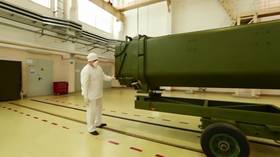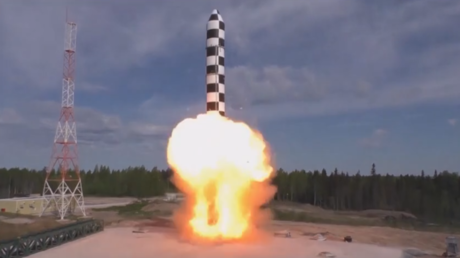No limits for 'Russian Tomahawks'? What we know about Moscow’s new nuclear cruise missile

Russia’s new nuclear cruise missile has entered the final stage of development following reports of successful tests. Officials say Burevestnik ('Storm Petrel') will have "unlimited" range and can outmaneuver any known defenses.
The missile’s nuclear power unit was successfully tested back in January, Russian media reported on Friday, citing sources. This "crucial" stage of testing "confirmed" that the reactor allows the missile to travel to an "unlimited range."
The military didn’t officially confirm the story, and it is not clear where and when the test reportedly took place. The videos released by the missile’s development team earlier showed how the engineers, dressed in all white and wearing safety masks, were carefully examining the prototype at an undisclosed location. The weapon itself was partially covered in the footage.
The weapon’s ambitious concept was unveiled by President Vladimir Putin during his State of the Nation address last March. The 9M730 Burevestnik, known as SSC-X-9 Skyfall under its NATO reporting name, is designed as a nuclear-powered and nuclear-armed intercontinental cruise missile capable of traveling "unlimited distances." It is even able to circle around the globe for days, if required.
The military says that its ability to traverse virtually any distance will be coupled with an equally astounding "unlimited ability to maneuver." It will make the missile extremely hard to intercept while penetrating an enemy’s defenses.
If the weapon becomes fully operational, Moscow will be able to launch missiles "from the Asian mainland, program them to cross the Pacific, go around South America, and penetrate US airspace from the Gulf of Mexico," Popular Mechanics wrote earlier this week.

Last week, Washington DC-based publication the Diplomat reported that the missile went through a "partially successful" test on January 29 at a site in southern Russia. The report, which cited US government sources, noted that "no country to date" has deployed a nuclear-powered cruise missile due to "engineering challenges" and safety concerns.
If successfully deployed, Burevestnik will indeed be unprecedented, given its features and capabilities. At the same time, its purpose is somewhat similar to the US long-range Tomahawk naval cruise missiles, except that their maximum range is limited to 2,500km (1,550 miles).
The Russian missiles' 'sister' project, the Poseidon nuclear-powered drone submarine, will undergo its sea trials this summer, the sources told local media. The project reportedly underwent successful nuclear power unit testing as well. Earlier reports suggested that the drone, which was described as a large nuclear-capable torpedo, would be able to travel at a speed up to 200kph (125mph) and dive as deep as 1km.
Think your friends would be interested? Share this story!















